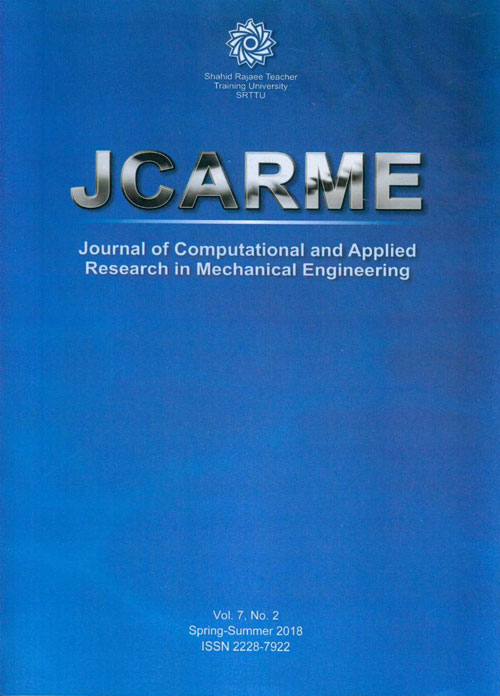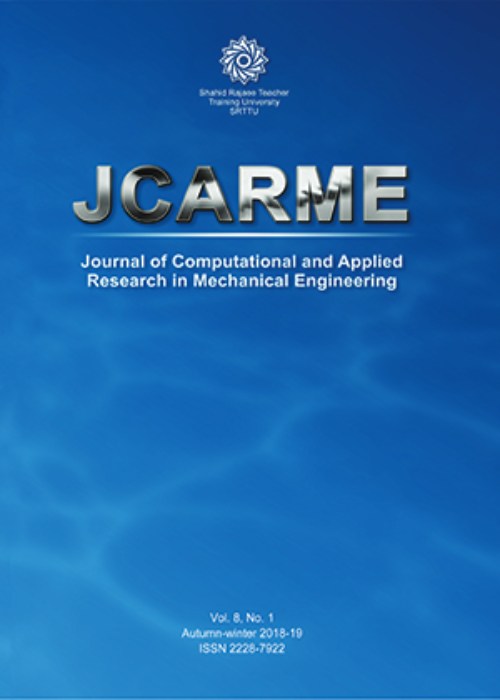فهرست مطالب

Journal of Computational and Applied Research in Mechanical Engineering
Volume:7 Issue: 2, Summer 2018
- 126 صفحه،
- تاریخ انتشار: 1397/01/15
- تعداد عناوین: 10
-
-
Page 137In this study, the Brownian motion and thermophoresis effects on the MHD ferrofluid flow over a cone with thermal radiation were discussed. Kerosene with the magnetic nanoparticles (Fe3O4) was considered. A set of transformed governing nonlinear coupled ordinary differential equations were solved numerically using Runge-Kutta based shooting technique. A simulation was performed by mixing ferrous particles with base fluids. Also, dual solutions for Casson Ferrofluid flow over a cone with rotation and without rotation effects were presented. An agreement of the present solutions with those published in literature was found. The effect of dimensionless parameters on velocity, temperature and concentration profiles along with the friction factor coefficients, Nusselt number, and the Sherwood numbers were discussed with the help of graphs and tables. It was found that the volume fraction of Ferro nanoparticles, magnetic field parameter, and Brownian motion parameters are controlling the friction factor coefficients, Nusselt number and Sherwood numbers for both the rotation and without rotation effects cases.Keywords: Ferrofluid, Brownian motion, Thermophoresis, MHD, Cone, thermal radiation, Mixed convective conditions
-
Page 151In this study, a numerical solution of 2D steady incompressible lid-driven cavity flow is presented. Three different numerical schemes were employed to make a comparison on the practicality of the methods. An alternating direction implicit scheme for the vorticity-stream function formulation, explicit and implicit schemes for the primitive variable formulation of governing Navier-Stokes equations were attempted. A fairly fine uniform grid was adopted for all the cases after a technical procedure was applied to come up with the proper mesh size that would make the solution roughly independent of mesh quality. The solutions obtained for different Reynolds numbers are presented and compared. Superiority of numerical approaches was investigated and compared to benchmark solutions available in the literature. Based on the results of the present research, it can be claimed that explicit scheme used for primitive variable formulation can be only half the way (as in Re=2500 for explicit to Re=5000 for ADI and implicit schemes) as successful as the other two numerical methods due to its relative simplicity.Keywords: Convergence criterion, Implicit solution, Primitive variable, Vorticity
-
Page 161In this study, the momentum and energy equations of laminar flow of a non-Newtonian fluid are solved in an axisymmetric porous channel using the least square and Galerkin methods. The bottom plate is heated by an external hot gas, and a coolant fluid is injected into the channel from the upper plate. The arising nonlinear coupled partial differential equations are reduced to a set of coupled nonlinear ordinary differential equations using stream function.These equations can be solved using the different numerical method. The numerical solution is conducted using fourth order Rung-Kutta method. With comparing the results obtained from the analytical and numerical methods, a good adaptation can be seen between them. It can also be observed that the results of the Galerkin method have further conformity with the numerical results and the Galerkin method is simpler than the least square method and requires fewer computations. The effects of Reynolds number, Prandtl number and power law index of non-Newtonian fluid is examined on flow field and heat transfer. The results show that Nusselt number increases by increasing Reynolds number, Prandtl number, and power law index.Keywords: Non-Newtonian fluid, Axisymmetric channel, Heat transfer, Least square method (LSM), Galerkin method (GM)
-
Page 175This paper presents the results of mechanical strength of wet and dry zirconia/ Nafion® nano-composite membrane. The tensile tests were conducted to determine elastic modulus and stiffness of dry and wet pristine Nafion® membrane and modified Nafion® membrane. The composite membranes were prepared by recast method of different synthesized zirconium oxide with the zirconia content of 10% by weight. The uniaxial mechanical properties of nano-composite membranes and recast Nafion® membrane were captured using a CellScale UStretch uniaxial testing system. The length, width, and thickness of samples were measured using a Vernier caliper and recorded prior to testing. It was found that elastic modulus of the wet Nafion recast is 62.06 %, 35.26 %, 30.79 % and 35.26 % higher than that of Nafion®/ Zr-100, Nafion/® Zr-80, Nafion®/Zr-50, and Nafion®/Zr-0, respectively. The elastic modulus of dry Nafion recast, Nafion®/Zr-100, Nafion®/Zr-80, Nafion®/Zr-50, and Nafion/Zr-0 membranes are 46.29 %, 83.31 %, 64.81 %, 59.84 %, and 78.36 % higher than those of wet Nafion® recast, Nafion®/Zr-100, Nafion®/Zr-80, Nafion®/Zr-50, and Nafion®/Zr-0 membranes, respectively. Furthermore, the results showed that when the water content increases in the nano-composite membranes the mechanical strength also decreases.Keywords: Tensile strength, Stiffness of nano membrane, Nano-composite, Relative humidity
-
Page 189This study investigated the optimization of three welding parameters (wire feed speed, arc voltage, and shielding gas flow rate) for SS 304H by using Taguchi based Grey relational analysis. In this research work, pure argon was used as shielding gas. Numbers of trials were performed as per L16 (4xx3) orthogonal array design and the mechanical quality such ultimate tensile strength, microhardness, Toughness, and microstructure of SS304H optimized by Grey-based Taguchi analysis and result shows that the optimal parameters combination were as A4B4C3 i.e. flow rate at 23L/min, voltage at 25 V and welding speed at 350IPM and it was observed that wire feed speed had the most significant effect followed by voltage and gas flow rate. An optimal combined parameter of the welding operation was obtained via Grey relational analysis. By analyzing Grey relational grade matrix, the degree of influence for each controllable process factor onto individual quality targets can be found.Keywords: SS304H, Mechanical properties, Taguchi technique, Grey relational analysis, SEM
-
Page 199A numerical study of hemodynamic parameters of pulsatile blood flow is presented in a stenotic artery with
A numerical study of hemodynamic parameters of pulsatile blood flow is presented in a stenotic artery with non-Newtonian models using ADINA. Blood flow was considered laminar, and the arterial wall was considered rigid. Studied stenosis severities were 30, 50, and 70% of the cross-sectional area of the artery. Six non-Newtonian models were used to model the non-Newtonian behavior of blood, and their results were compared with the Newtonian model. The results showed that in Power-law and Walburn-Schneck models, unlike other models, shear stress values before and after the stenosis were smaller than Newtonian models. Also, in maximum flow rate, the Carreua, generalized Power-law, Casson, and Carreua-Yasuda models showed a reduction in global importance factor of non-Newtonian behavior, and subsequently, the results approached Newtonian model. In minimum flow rate, the global importance factor of Newtonian behavior increased, which highlighted the importance of Newtonian model. In minimum flow rate, Carreua-Yasuda model was more sensitive to the non-Newtonian behavior of blood compared to Carreua, Casson, and Power-law models. Also, in that time period, Walburn-Schneck was less sensitive to the non-Newtonian behavior of blood. On the other hand, this model did not show sensitivity when the flow rate was at its peak. Power-law model overestimated the global importance factor values. Therefore, Power-law model was not suitable, because it showed extreme sensitivity to dimension. Walburn-Schneck model was not suitable too because it lacked sensitivity.Keywords: Pulsatile flow, Non-Newtonian fluid, Stenosis, Important global factor -
Page 209This study deals with the three-dimensional flow of a chemically reacting magnetohydrodynamic Sisko fluid over a bidirectional stretching surface filled with the ferrous nanoparticles in the presence of non-uniform heat source/sink, nonlinear thermal radiation, and suction/injection. After applying the self-suitable similarity transforms, the nonlinear ordinary differential equations are solved numerically using Runge-Kutta and Newtons methods. Results present the effects of various non-dimensional governing parameters on velocity, temperature and concentration profiles. Also, computed and discussed the friction factor coefficients along with the local Nusselt and Sherwood numbers. Similarity solutions for suction and injection cases are presented. A good agreement in the present results with the existed literature under some special limited cases is found. It is found that heat and mass transfer performance of Sisko ferrofluid is significantly high in injection case when compared with the suction case. Increasing values of the stretching parameter enhance the heat and mass transfer rate.Keywords: MHD, Sisko ferrofluid, Non-uniform heat source, sink, Nonlinear thermal radiation, chemical reaction
-
Page 223Reaming is a common finishing process for improving the drilled holes surface quality. Choosing an appropriate finishing method in drilling process has a significant effect on the surface quality of holes and in decreasing the process total cost and time. In this study, four similar holes were drilled on the AISI 4340 workpiece with different two pair feed rates. The drilling process was performed with a conventional cutting fluid, an emulsion of water and ECOCOOL 3015 GS-W. The surface roughness values after drilling process were measured using a portable roughness tester. Then, two distinct sizes of alumina micro-particles were used in the cutting fluid discretely to perform finishing process of the holes with a specific cylindrical tool. A comparison of the surface roughness measurements after the finishing process showed a significant decrease in the arithmetic surface roughness and ten-point mean roughness values of the drilled holes. The values were very close to the surface roughness limits in reaming process of the holes.Keywords: Alumina, Drilling, Surface quality, Cutting fluid, Feedrate
-
Page 233In this study, we presented a mathematical model for analyzing the heat source/sink effect on magnetohydrodynamic two-dimensional ferrofluid flow past a cone and a vertical plate in the presence of volume fraction of ferrous nanoparticles. The governing partial differential equations are transformed as ordinary differential equations making use of similarity solutions and solved numerically with the aid of Runge-Kutta based shooting technique. The limiting case of the present results shows a good agreement with the published results. We presented solutions for the flow over a cone and a vertical plate cases. The influence of dimensionless parameters on velocity and temperature profiles along with the friction factor coefficient and the heat transfer rate are analyzed with the help of graphs and tables. It is found that the rising value of the volume fraction of ferrous nanoparticles enhances the friction factor coefficient and heat transfer rate. It is also found that heat transfer performance of the flow over a plate is comparatively higher than the flow over a cone.Keywords: MHD, Convection, Heat source, sink, Ferrofluid, Cone, Plate
-
Page 243In fracture mechanics and failure analysis, cracked media energy and consequently stress intensity factors (SIFs) play a crucial and significant role. Based on linear elastic fracture mechanics (LEFM), the SIFs and energy of cracked media may be estimated. This study presents the novel modification of decoupled scaled boundary finite element method (DSBFEM) to model cracked media. In this method, only the boundaries of problems are discretized using specific higher-order sub-parametric elements and higher-order Lagrange polynomials as mapping functions. Implementing the weighted residual method and using Gauss-Lobatto-Legendre numerical integration yield diagonal Eulers differential equations. The chief modifications among the research conducted and the previous studies concerning DSBFEM is that here in, generation of geometry process of the functional interpolation, integration of the diverse is chosen, and by current technic, the difficulty of the DSBFEM is decreased. Therefore, when the local coordinates origin is located at the crack tip, the geometry of crack problems are implemented directly without further processing. Validity and accuracy of the proposed method are fully illustrated through three benchmark problems, whose results agree very well with those of other numerical and/or analytical solutions existing in the literature.Keywords: Decoupled scaled boundary finite element method (DSBFEM), Linear elastic fracture mechanics (LEFM), Fracture parameters, Lagrange polynomials, Gauss-Lobatto-Legendre integration


